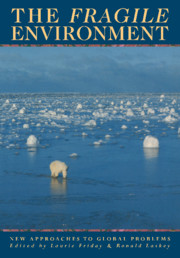7 - Changing climates
Published online by Cambridge University Press: 03 May 2010
Summary
Climatic changes in the past
The climate on earth has changed throughout the evolution of our planetary system over about 4500 million years. Sometimes these changes have been rapid. During other periods they have been slow, hardly noticeable over millions of years, as far as we can judge from the evidence that is found to-day in rocks and sediments. To be able to discuss possible future climates we must understand the mechanisms behind past changes. The climatic system is too complex for us to rely merely on simple extrapolation of observed trends and variations or theoretical models that have not been tested against past data.
We know the gross features of climatic change on earth during the last major geological epochs, i.e. during the last few hundred million years. These have been determined by analyses of the abundance of the oxygen-18 isotope in remains of planktonic micro-organisms (foraminifera). The ratio of oxygen-18 to the normal isotope, oxygen-16, reflects water temperature and global ice volume. High proportions of oxygen-18 correspond to glacial periods when more of the lighter isotope oxygen-16 was locked up in ice. These analyses reveal that water temperatures in the deep layers of the oceans have been close to zero degrees only during the last few million years, i.e. the Quaternary period, and also that ocean surface temperatures were probably higher during these earlier periods than they are today (Fig. 7.1). Presumably the climate on land was also significantly different from to-day.
A much more detailed record of the proportion of oxygen present as oxygen-18 for the Quaternary period shows marked variations on much shorter timescales.
- Type
- Chapter
- Information
- The Fragile EnvironmentThe Darwin College Lectures, pp. 127 - 147Publisher: Cambridge University PressPrint publication year: 1989
- 1
- Cited by

